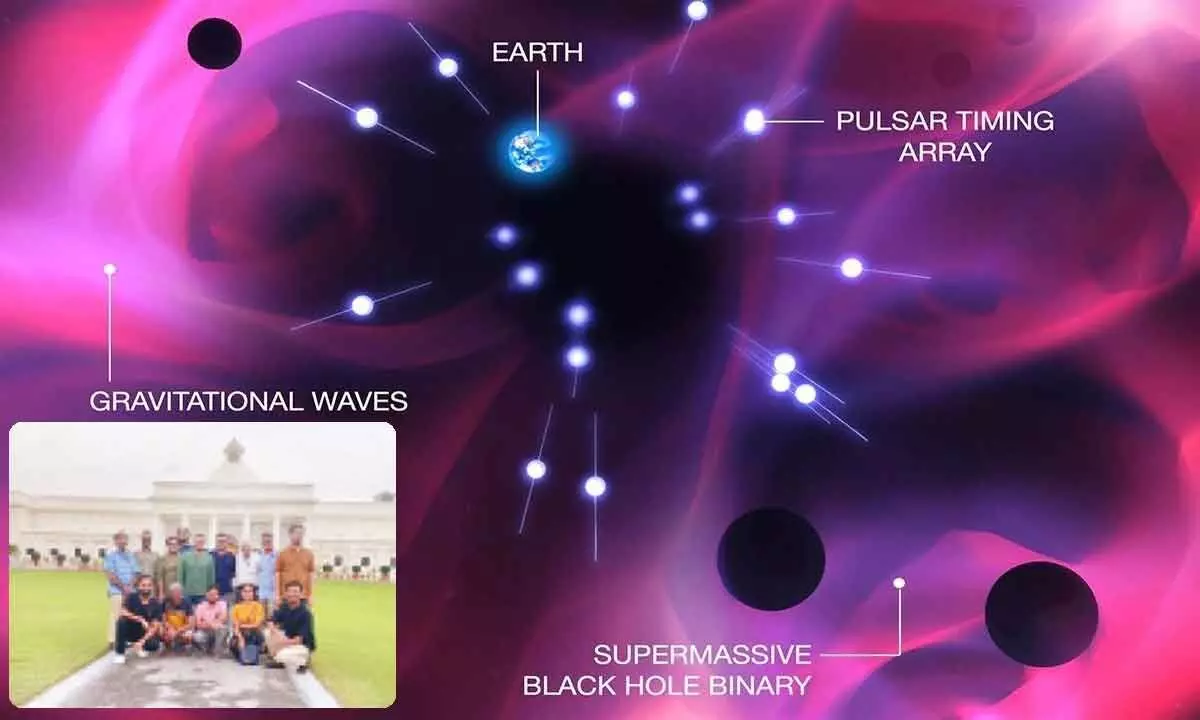Live
- Nizamabad MP Dharmapuri Arvind and Jagtial MLA Dr. Sanjay Kumar Meet CM Revanth Reddy
- Hyderabad CP CV Anand Issues Stern Warning to Bouncers
- MP Laxman Criticizes Police Conduct, Calls for Support for Victims' Families
- Fire Breaks Out in Kachiguda-Chennai Egmore Express, Passengers Evacuated Safely
- CM Revanth Reddy Condemns Attacks on Film Personalities' Homes, Calls for Strict Action
- Victory Venkatesh and Nandamuri Balakrishna to Set Screens on Fire with Unstoppable Season 4
- Over 71.81 crore Ayushman Bharat Health Account numbers generated: Centre
- In special gesture, Kuwait's Prime Minister sees-off PM Modi at airport after conclusion of historic visit
- Veer crowned PGTI Ranking champion, Shaurya wins emerging player honour
- Sr National Badminton: Unseeded Rounak Chauhan, Adarshini Shri reach singles semis
Just In
Indian researchers find evidence of ultra-low frequency gravitational waves


To detect these gravitational-wave signals, astronomers created a “galactic-scale gravitational-wave detector”, which was synthesised by incorporating 25 meticulously chosen pulsars in our Milky Way Galaxy
Roorkee: In a significant breakthrough, an international team of astronomers including from the Indian Institutes of Technology (IIT) Roorkee has provided scintillating evidence for the relentless vibrations of the fabric of our universe caused by ultra-low frequency gravitational waves.
The team, including from Japan and Europe, found the evidence from monitoring pulsars - dubbed as nature’s best clocks - using six of the world’s most sensitive radio telescopes, including India’s largest telescope, the upgraded Giant Metrewave Radio Telescope (uGMRT).
To detect these gravitational-wave signals, astronomers created a “galactic-scale gravitational-wave detector”, which was synthesised by incorporating 25 meticulously chosen pulsars in our Milky Way Galaxy.
This helped the teams to access the variations in the pulse arrival times created by gravitational waves with a frequency of oscillation 10 billion times slower than those first observed in 2015 by the two ground-based LIGO detectors in the US.
The researchers explained that the ultra-low frequency gravitational waves originated from a large number of dancing monster black hole pairs with masses that are ten-to-hundred crores times more than the mass of our Sun.
Such dancing monster black hole pairs, expected to lurk in the centres of colliding galaxies, create ripples in the fabric of space-time, which the astronomers call nano-hertz gravitational waves.
The relentless cacophony of gravitational waves from a large number of supermassive black hole pairs create a persistent humming of our universe. These light-year-scale ripples can only be detected by synthesising a galactic-scale gravitational-wave detector using pulsars-the only accessible celestial clocks for humans.
The findings, led by members of the Indian Pulsar Timing Array (InPTA) and European Pulsar Timing Array (EPTA) consortia, were published in two seminal papers in the Astronomy and Astrophysics journal. These are a crucial milestone in opening a new, astrophysically-rich window in the gravitational wave spectrum.
“According to Einstein, gravitational waves change the arrival times of these radio flashes and thereby affect the measured ticks of our cosmic clocks. These changes are so tiny that astronomers need sensitive telescopes like the uGMRT and a collection of radio pulsars to separate these changes from other disturbances,” explained Prof. Bhal Chandra Joshi of NCRA Pune and Adjunct Faculty, IIT Roorkee, who founded the InPTA collaboration, in a statement.
“The slow variation of this signal has meant that it takes decades to look for these elusive nano-hertz gravitational waves,” he added.
For the galactic-scale gravitational-wave detector, data was collected over 25 years with six of the world’s largest radio telescopes, including more than three years of very sensitive data collected using the unique low radio frequency radio telescope, the uGMRT.
Measurements of the exact arrival times of the pulsar were compared with both data to study the influence of gravitational waves.
“The results presented today mark the beginning of a new journey into the Universe to unveil some of these mysteries. More importantly, this is the first time that an Indian telescope’s data is used for hunting gravitational waves,” said Prof. A. Gopakumar, TIFR, Mumbai, and Chair of the InPTA consortium.
The InPTA experiment involves researchers from NCRA (Pune), TIFR (Mumbai), IIT (Roorkee), IISER (Bhopal), IIT (Hyderabad), IMSc (Chennai) and RRI (Bengaluru) along with their colleagues from Kumamoto University, Japan.

© 2024 Hyderabad Media House Limited/The Hans India. All rights reserved. Powered by hocalwire.com






